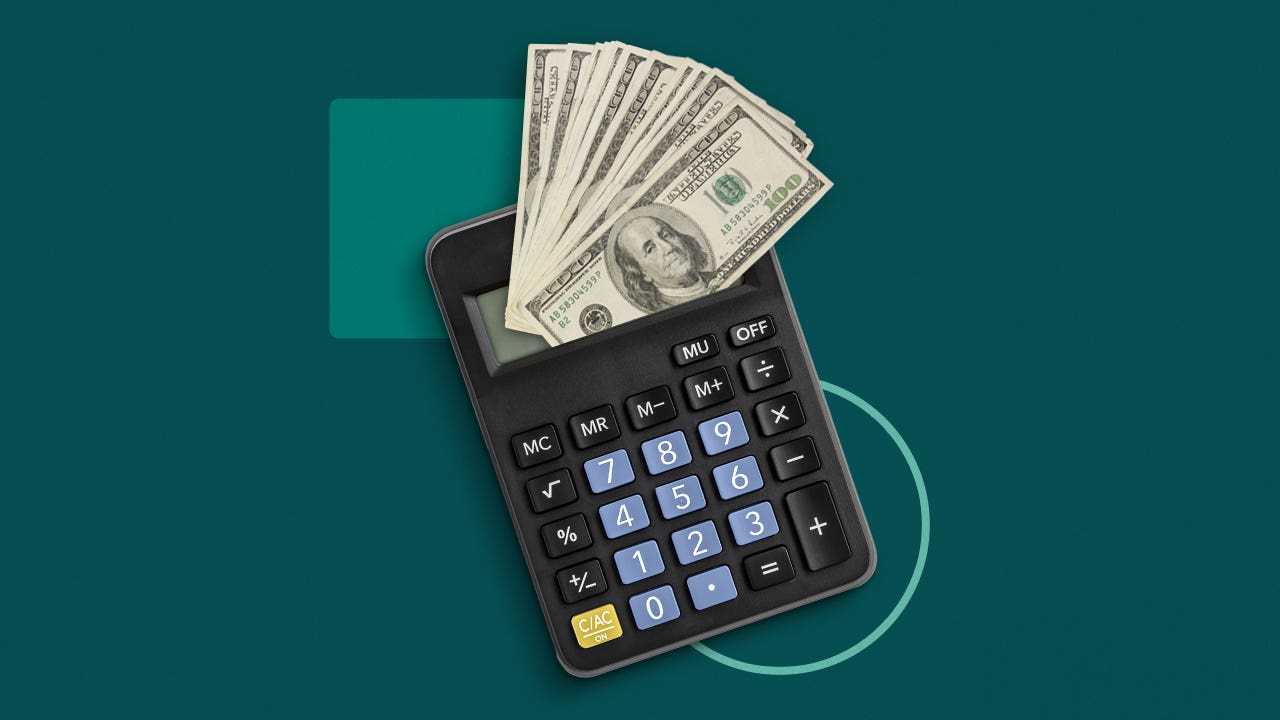How to calculate interest on a loan: Tools to make it easy

The Bankrate promise
At Bankrate we strive to help you make smarter financial decisions. While we adhere to strict , this post may contain references to products from our partners. Here's an explanation for .
Key takeaways
- Lenders charge two types of interest to earn money on the amount borrowed: simple or amortized.
- Short-term loans come with simple interest, while larger loans, like mortgages and some auto loans have an amortization schedule.
- With both simple and amortized interest loans, payments remain the same over the life of the loan. The difference, however, is in how interest is applied to the principal amount
There are two ways that lenders charge interest — simple or on an amortization schedule. In an amortizing loan, a portion of each monthly payment allocated specifically toward interest will decrease over time, and the amount allocated toward the principal balance will increase. With a simple interest loan, the amount of interest allocated toward the total monthly payment remains the same throughout the entirety of the term.
How to calculate the total interest charges will differ between the two types of accrual. While you can use a calculator, knowing the difference between the two formulas is useful for gaining a well-rounded view of your total loan balance.
How to calculate simple interest on a loan
If a lender uses the simple interest method, it’s easy to calculate loan interest if you have the right information available. You will need your principal loan amount, interest rate and loan term to calculate the overall interest costs.
The monthly payment is fixed, but the interest you’ll pay each month is based on the outstanding principal balance. So, if you pay off the loan early, you could save a sizable amount in interest, assuming the lender doesn’t charge a prepayment penalty.
Formula for calculating simple interest
- Principal loan amount x interest rate x loan term = interest
Who benefits from simple interest
Borrowers who make on-time or early payments benefit from simple interest. Because interest is calculated based only on the loan principal, borrowers can save with these loans as opposed to those with compound interest.
Types of loans that use simple interest
While simple interest is less common, you might encounter this form of interest on short-term loans, such as payday loans and car title loans, as well as some personal loans, vehicle loans and mortgages.
Those with student loans may also pay simple interest. For instance, all federal student loans charge simple interest.
How to calculate amortizing interest on a loan
Many lenders charge interest based on an amortization schedule. This includes mortgages and some auto loans. The monthly payment on these types of loans is also fixed — the loan is paid over time in equal installments. However, how the lender charges interest changes over time.
The main difference between amortizing loans and simple interest loans, however, is that with amortizing loans, the initial payments are generally interest-heavy. That means a smaller portion of your monthly payment goes toward your principal loan amount.
However, as time passes and you draw closer to your loan payoff date, the table turns. Toward the end of your loan, the lender applies most of your monthly payments to your principal balance and less toward interest fees.
Formula for calculating amortized interest
- Divide your interest rate by the number of payments you’ll make that year. If you have a 6 percent interest rate and you make monthly payments, you would divide 0.06 by 12 to get 0.005.
- Multiply that number by your remaining loan balance to find out how much you’ll pay in interest that month. If you have a $5,000 loan balance, your first month of interest would be $25.
- Subtract that interest from your fixed monthly payment to see how much in principal you will pay in the first month. If your lender has told you that your fixed monthly payment is $430.33, you will pay $405.33 toward the principal for the first month. That amount gets subtracted from your outstanding balance.
Repeat the process with your new remaining loan balance for the following month, and continue repeating for each subsequent month.
Here’s the amortization schedule for a $5,000, one-year personal loan with a 12.21 percent interest rate, the average interest rate on personal loans in late May 2024.
| Payment Date | Payment | Principal | Interest | Total Interest | Balance |
|---|---|---|---|---|---|
| May 2024 | $444.76 | $393.84 | $50.92 | $$50.92 | $4,606.16 |
| June 2024 | $444.76 | $397.85 | $46.91 | $97.82 | $4,208.31 |
| July 2024 | $444.76 | $401.90 | $42.85 | $140.68 | $3,806.40 |
| Aug. 2024 | $444.76 | $406.00 | $38.76 | $179.44 | $3,400.40 |
| Sept. 2024 | $444.76 | $410.13 | $34.63 | $214.07 | $2,990.27 |
| Oct. 2024 | $444.76 | $414.31 | $30.45 | $244.52 | $2,575.97 |
| Nov. 2024 | $444.76 | $418.53 | $26.23 | $270.75 | $2,157.44 |
| Dec. 2024 | $444.76 | $422.79 | $21.97 | $292.72 | $1,734.65 |
| Jan. 2025 | $444.76 | $427.09 | $17.66 | $310.38 | $1,307.56 |
| Feb. 2025 | $444.76 | $431.44 | $13.32 | $323.70 | $876.11 |
| March 2025 | $444.76 | $435.84 | $8.92 | $332.62 | $440.28 |
| April 2025 | $444.76 | $440.28 | $4.48 | $337.10 | $0.00 |
Who benefits from amortized interest
Lenders are the primary beneficiaries of amortized interest. Payments are applied to both principal and interest, extending the length of the loan and increasing the interest paid over time.
Types of loans that use amortized interest
Many types of installment loans use amortized interest, including auto loans, mortgages and debt consolidation loans. You may also encounter amortized interest on home equity loans.
Factors that can affect how much interest you pay
Many factors can affect how much interest you pay for financing. Here are some primary variables that can impact how much you will pay over the loan life.
Loan amount
The amount of money you borrow (your principal loan amount) greatly influences how much interest you pay to a lender. The more money you borrow, the more interest you’ll pay because it means more of a risk for the lender.
If you borrow $20,000 over five years with a 5 percent interest rate, you’ll pay $2,645.48 in interest on an amortized schedule. If you keep all other loan factors the same (e.g., rate, term and interest type) but increase your loan amount to $30,000, the interest you pay over five years would increase to $3,968.22.
Your credit score
Your credit score plays a key role in determining your loan’s interest rate. Less-than-perfect credit typically means you will get a higher interest rate, as lenders consider you a bigger risk than someone with excellent credit.
Building on the previous example ($20,000, five-year term, amortized interest), let’s compare a 5 percent loan with a 7 percent loan. On the 5 percent loan, the total interest cost is $2,645.48. If the interest rate increases to 7 percent, the interest cost rises to $3,761.44.
Loan term
A loan term is the time a lender agrees to stretch out your payments. So if you qualify for a five-year auto loan, your loan term is 60 months. Conversely, mortgages commonly have 15- or 30-year loan terms.
The months it takes to repay the money you borrow can significantly impact your interest costs.
Shorter loan terms generally require higher monthly payments, but you’ll incur less interest because you minimize the repayment timeline. Longer loan terms may reduce the amount you need to pay each month, but because you’re stretching repayment out, the interest paid will be greater over time.
Repayment schedule
How often you make payments to your lender is another factor to consider when calculating interest on a loan. Most loans require monthly payments (though weekly or biweekly, especially in business lending). If you opt to make payments more frequently than once a month, there’s a chance you could save money.
When you make payments more often, it can reduce the principal owed on your loan amount faster. In many cases, such as when a lender charges compounding interest, making extra payments could save you a lot. However, make sure the payments go to paying down the principal.
Repayment amount
The repayment amount is the dollar amount you must pay on your loan each month.
In the same way that making loan payments more frequently can save you money on interest, paying more than the monthly minimum can also result in savings.
How to get the best loan interest rates
You may be able to improve your chances of obtaining the most favorable interest rate on a loan in a few ways:
- Improve your credit score: The most competitive interest rates are generally available to those with the highest credit scores.
- Opt for a shorter repayment timeline: The best interest rates will always accompany the shortest-term loans. You will pay less interest over time if you can afford the payments.
- Reduce your debt-to-income ratio: Your debt-to-income (DTI) ratio is the monthly debt you pay as a percentage of your gross monthly income. It is nearly as significant as your credit score when qualifying for a competitive loan.
- Compare offers: Loans aren’t a one-size-fits-all type of product — each lender has its own offering. Prequalify with at least three different lenders to ensure you get the best rates. Prequalifying allows you to see the terms and interest rates available to you with a specific lender without hurting your credit.
The bottom line
Before taking out a loan, it’s vital to calculate how much you’ll pay in interest to understand the true borrowing costs. Ask the lender if interest is assessed using the simple interest formula or an amortization schedule, and use the appropriate formula or an online calculator to run the numbers.
Also, be mindful of the factors that will affect the interest you pay. It may be worthwhile to borrow less or shorten the repayment term to keep more of your hard-earned money in your pocket. Furthermore, you should improve your credit score before applying and shop around to ensure you get the best deal on a loan.



